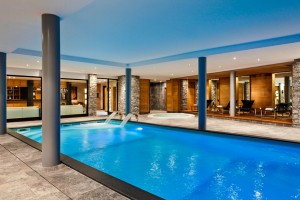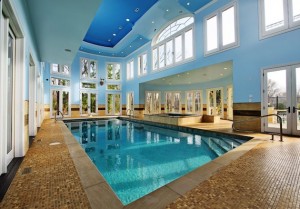Save Thousands by Choosing The Right Indoor Swimming Pool Builder
Choosing the right company for your indoor swimming pool design and construction project is critically important. Indoor pool environments are humid places by design, but far too many suffer from excessive humidity, which establishes itself in the shape of premature degradation, foggy windows or outright rotting of building materials, and just plain stinky, steamy atmosphere. Hotel owners and homeowners who’ve assembled these indoor pools often get a bit steamed themselves when their indoor swimming pools need repair.
Excessive-humidity problems generally stem from building design techniques, pool construction material choices, or setup and design/build mistakes. For this reason, it is critical the pool builder you decide on understands the four fundamental indoor pool principles — water chemistry, air distribution, mechanical equipment and architecture. A deficiency in any single component affects the whole endeavor and all of the other parts.
Architecture And Construction of Indoor Swimming Pools
 Way too many hotel and resort pools are poorly engineered and have multiple installation blunders with obvious cutting of corners on their indoor swimming pool construction projects. The entire swimming pool area becomes a moldy, rotting toxic mess. These issues appear when the pool builder takes on a project outside their scope of knowledge. Their plan is created around environments that are normal, and they forget the aquatic environment is year-round 85 degrees with 60 degree dew points.
Way too many hotel and resort pools are poorly engineered and have multiple installation blunders with obvious cutting of corners on their indoor swimming pool construction projects. The entire swimming pool area becomes a moldy, rotting toxic mess. These issues appear when the pool builder takes on a project outside their scope of knowledge. Their plan is created around environments that are normal, and they forget the aquatic environment is year-round 85 degrees with 60 degree dew points.
It’s important to consider that the environment for the indoor pool is going to be like the worst days of August. When you consider it in those terms, the entire project changes. From selecting building materials to each minute detail of installation, indoor commercial pool construction and indoor home swimming pool construction requires a highly specialized builder.
The importance of Vapor Barriers
Often overlooked or poorly chosen, is the vapor barrier. Occasionally they’re installed incorrectly, but other times they aren’t present at all. It’s very important that they are not only used and installed correctly, but also that the selected barrier is among the highest quality available. This choice alone can be the difference between rotting wood, mold, and mildew.
Windows For Your Natatorium
Most indoor pool rooms may have some windows and it’s vital that you select windows that can withstand the intense environment of an indoor pool. Windows must be triple or double paned to cut back on condensation. Try to avoid condensation at all costs, so we can keep all of the rest of the dry building materials dry throughout the year.
Air flow within your Indoor Swimming Pool Environment
 Additional essential elements in a well-designed and properly built indoor pool environment include air quality and proper dehumidification. These systems function a lot like air conditioners that are super-charged, except that they discharge warm, dry air as opposed to air that is chilled. They are also made to manage much larger amounts of humidity. However, no matter how big, or how expensive your system is, it will not work if the air is not moving at the angle and to the locations it needs to be.
Additional essential elements in a well-designed and properly built indoor pool environment include air quality and proper dehumidification. These systems function a lot like air conditioners that are super-charged, except that they discharge warm, dry air as opposed to air that is chilled. They are also made to manage much larger amounts of humidity. However, no matter how big, or how expensive your system is, it will not work if the air is not moving at the angle and to the locations it needs to be.
The environment around your indoor swimming pool will typically have high humidity and consequently, high dew points making the moisture in the atmosphere condense into water. Keeping surfaces warm helps prevent this from occurring.
Choosing The Best Equipment For Your Indoor Swimming Pool
First and foremost, we consider the size of the space and the average outdoor temperature, but we also discuss how the homeowners or resort operators plan to utilize the room. A common design includes a four-degree temperature differential between the air and water — 80-degree air, 84-degree water. If the homeowner or resort managers prefer something different — 75-degree air and 88-degree water, for example — their decision will significantly affect evaporation rates and dehumidifier sizing calculations. It’s very important for the hotel operator or homeowner to know after the equipment is ordered, that atmosphere and pool water temperature set point are locked together.
Indoor Swimming Pool Chemistry
The last piece of the indoor pool puzzle is pool water chemistry. It’s the simplest bit of the puzzle, but like the rest of the components, neglect to pay it proper attention it can cause big problems over time. If we aren’t going to be caring for your indoor swimming pool, we can set up a maintenance schedule that includes water chemistry. Please remember – never store pool chemicals in the mechanical room (a commonly overlooked rule) or in an unventilated closet.
Some indoor swimming pool builders will undoubtedly provide a price quote that is low to get your business. But beware – you will end up spending a lot more to fix the problems that are likely to arise then you would have spent by choosing a more experienced company. We cannot say this enough… don’t choose a low cost swimming pool company when you are placing an indoor pool in. If you’re getting a deal, they’re going to cut corners. The cost increase between doing things right and doing them wrong is far less than replacing walls, windows, removing mold, and replacing or fixing equipment.
